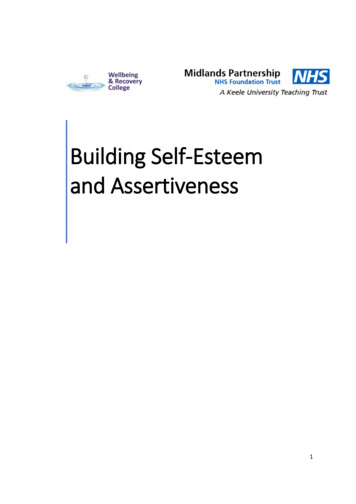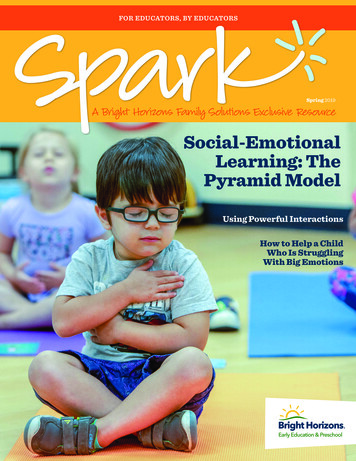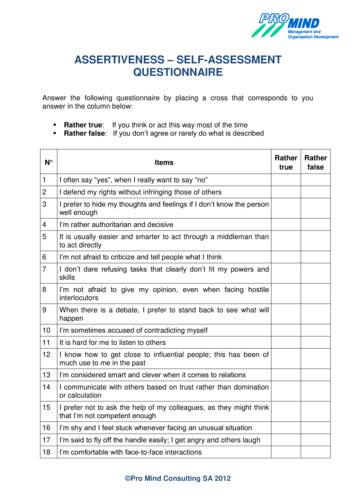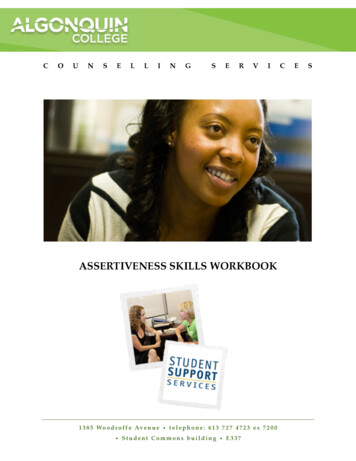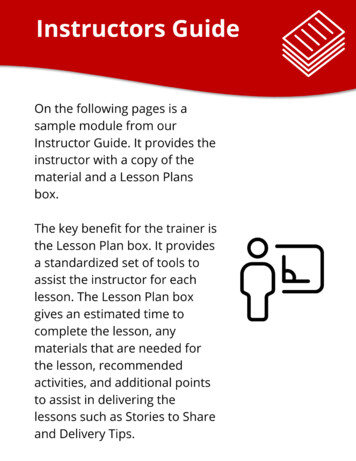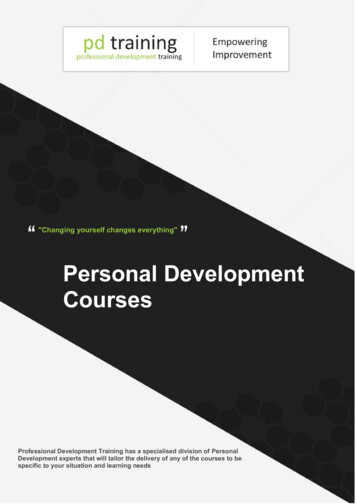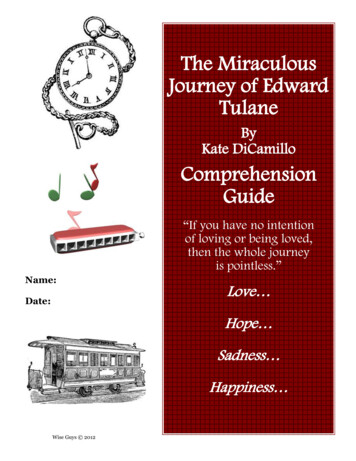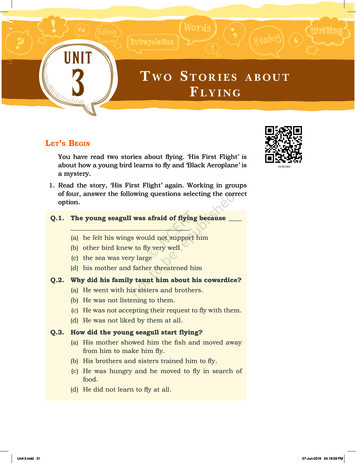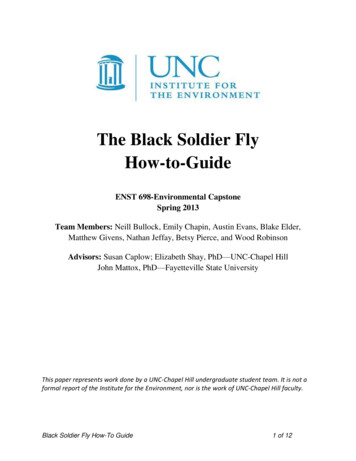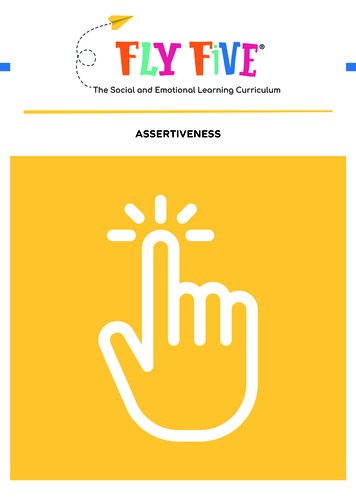
Transcription
ASSERTIVENESS
2Assertiveness:The Apex ofCommunicationOf all the C.A.R.E.S. competencies, assertiveness mightbe the most difficult to clearly articulate. What oneperson considers assertive communication anothermay consider aggressive communication, and onestyle can slip into another depending on the situation.Tone of voice or word choice can impact whether or notsomeone is viewed as passive, assertive, or aggressive,and these factors can impact the trajectory of a conflictor conversation. Although assertiveness is nuanced andcomplex, it encompasses an important set of skills forboth adults and students.Whether educators and students are transitioning fromat-home to in-person learning, experiencing prolongeddistance learning, or navigating a semblance of both,assertiveness skills help individuals work throughchallenges, nurture resilience, and advocate for theirneeds. These are crucial skills for success in the face ofongoing challenges.FLY FIVE
FLY FIVE3
4FLY FIVEThe Impact ofAssertivenessAssertiveness characterizes howsomeone responds when their ideas orinterests are or may come to be at oddswith someone else’s (Ames, 2009).Assertiveness skills are associatedwith success in responding to criticism,solving conflicts, and asking for helpor favors (Vagos & Pereira, 2016).It is fundamental for establishingpositive relationships, and developingassertiveness allows individuals to standup for their rights and interests withoutdenying the rights and interests ofothers (Speed et al., 2018).Assertive individuals are associated with stronger self-esteem (Eslami et al.,2016), which helps them learn to say “no” respectfully. Finally, assertivenessfosters the skills necessary for talking openly and honestly about one’spositive and negative feelings (Peneva & Mavrodiev, 2013), making it usefulin lowering anxiety and depression and giving individuals a greater sense ofagency (Malkin, 2011; Mohebi et al., 2012). With its positive influence on socialand emotional growth, there’s no question that assertiveness deserves aprominent place in a student’s education.
5FLY FIVEAssertiveness in Fly FiveIn the Fly Five curriculum, assertiveness is defined as “the ability to take initiative, to stand up for one’s ideas without hurting or negating others, to seek help,to persevere with a challenging task, and to recognize one’s individual self asseparate from the environment, circumstances, or conditions one is in.” The FlyFive assertiveness standards are:01Expresses strong emotionsand opinions effectively03Shows openness andhonesty02Able to seek help04Persists throughchallenging events
6FLY FIVEDeveloping assertiveness not only helps students practice a constructive andpositive communication style, it also can foster deeper learning. When studentscan effectively ask for help and make positive choices, they can communicatetheir struggles effectively, decreasing the likelihood of derailing an entire classroom. Increased assertiveness is associated with decreased aggression and increased self-efficacy; stronger self-efficacy skills allow students to enjoy betteracademic outcomes (Mofrad & Mehrabi, 2015).
FLY FIVE7Strategies for FosteringAssertivenessAssertiveness is not an innate quality, but rather a learned skill that iscontingent upon factors such as social class, family life, gender, andenvironment (Hinde, 2018), among others. Adults can foster assertivenessskills with the following strategies: Use role-playing and/or mirror work. Role-playing and rehearsing in themirror helps students work on assertive language and body posturesin low-stakes situations. Demonstrate assertive body postures and anassertive tone of voice; offer a list of respectful, assertive vocabulary wordsto use. Then, have students practice in small groups or on their own. Seeingassertiveness in themselves and their peers helps students understandwhat assertive communication looks like so they can match the messagestheir body language and voices to the message they want to send (UWA,2018). Explore different communication styles with students. Help studentsunderstand that there are four different types of communication:Aggressive, Passive Aggressive, Passive, and Assertive. For students ingrades K–2, encourage them to draw four different faces that expressthese styles, then discuss their understanding of each. As students entergrades 3–5 and 6–8, explore situations in books and movies. When arestudents’ favorite characters being assertive? When are they being passiveor aggressive? When students are able to recognize and name differentcommunication styles in others, they will be better able to do the same inthemselves.
8FLY FIVE Teach students about boundaries. Students in grades K–2 can considerreal boundaries they’ve encountered in life, such as a fence, a moataround a castle, or the walls of their home. What purpose do theseboundaries serve? What are the characteristics of a constructiveboundary? Students can also think about how they can be respectfulof what’s inside the boundary. Students in grades 3–5 and 6–8 canpractice setting their own boundaries. Offer sentence stems such as“Thank you for asking, but I can’t help you with that right now.” Thesesentence stems guide students to saying no in an assertive way. Practice mindfulness. Students can use various mindfulness strategiesto develop a resilient, open attitude and strengthen their ability tocommunicate effectively (Jacobs, 2015). Mindful meditations withaffirmations, such as “I can do this'' or “I am capable” can build the selfesteem needed to communicate assertively.Assertiveness can be challenging for adults and students alike. However,assertiveness can be reliably taught and assessed (Elliott et al., 2015),and with consistent practice, everyone can acquire the skills needed todemonstrate this valuable competency. As individuals are increasingly able tobe clear and direct about their needs and communicate constructively, theyare positioned to live healthy, constructive lives well beyond the classroom.
FLY FIVE9ReferencesAmes, D. (2009). Pushing up to a point: Assertiveness and effectiveness inleadership and interpersonal dynamics. Research in Organizational Behavior,29, 111–133. https://doi.org/10.1016/j.riob.2009.06.010Elliot, S. N., Frey, J. R., & Davies, M. (2015). Systems for assessing students’social skills to achieve academic competence. In J. A. Durlak, C. E. Domitrovich,R. P. Weissberg, & T. P. Gullotta (Eds.), Handbook of social and emotionallearning: Research and practice (pp. 301–319). Guilford Press.Eslami, A. A., Rabiei, L., Afzali, S. M., Hamidizadeh, S., and Masoudi, R. (2016).The effectiveness of assertiveness training on the levels of stress, anxiety, anddepression of high school students. Iranian Red Crescent Medical Journal,18(1). 19/Hinde, J. (2018). Advantages of assertiveness training in team building.Nursing and Residential Care, 20(10). , T. (2015, October). Evidence mounts that mindfulness breedsresilience. Greater Good. ence mounts that mindfulness breeds resilienceKhademi Mofrad, S. H., & Mehrabi, T. (2015). The role of self-efficacy andassertiveness in aggression among high school students in Iisfahan. Journalof Medicine and Life, 8(4),: 225–-231. ssion-among-high-school-students-inisfahan/Malkin, C. (2011, August 6). The ABC’s of assertiveness: A simple guide tospeaking your mind. Psychology Today. dux/201108/the-abcs-assertivenessMohebi, S., Sharifarad, G. H., Shahsiah, M., Botlani, S., Matlabi, M., & Rezaeian,M. (2012). The effect of assertiveness training on student’s academic anxiety.Journal of the Pakistan Medical Association, 62(3), 37–41. https://jpma.org.
10FLY FIVEpk/supplement-article-details/33Peneva, I., & Mavrodiev, S. (2013). A historical approach to assertiveness.Psychological Thought, 6(1), 3–26. https://doi.org/10.5964/psyct.v6i1.14Speed, B. C., Goldstein, B. L., & Goldfried, M. R. (2017). Assertiveness training:A forgotten evidence-based treatment. Clinical Psychology: Science andPractice, 25(1). ty of West Alabama. (2018, March 30). Teaching assertiveness toelementary students. Teaching News. elementary-students/Vagos, P., & Pereira, A. (2016). A cognitive perspective for understanding andtraining assertiveness.European Psychologist, 21(2), 109–121. https://doi.org/10.1027/1016-9040/a000250
Assertiveness: The Apex of Communication Of all the C.A.R.E.S. competencies, assertiveness might be the most di cult to clearly articulate. What one person considers assertive communication another may consider aggressive communication, and on
